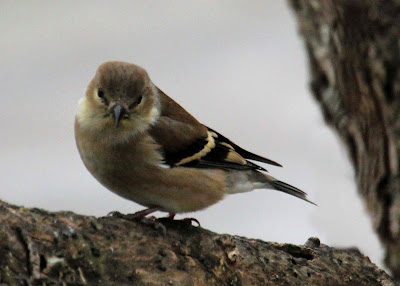By Beth Sullivan
We started off this
winter, in late fall actually, with one good snowstorm and a lot of
good birds. We all hoped this was going to be a big year for
northern species. Every once in a while, due to challenging
conditions in the northern regions, birds will move south in
irregular patterns. These are called irruptions. Some are more
noticeable, and stunning, than others. A few years ago we were seeing
beautiful snowy owls in local areas, in farm fields and coastal
areas, sandy beaches, and parking lots. That was a great winter! It
was attributed to a lower than normal supply of the small mammals
that the owls normally find on their home turf.
A diet of seeds
Other birds rely on
seeds from various sources. If a particular seed source becomes
scarce, they will move as well. Some rely on seeds from evergreen
conifers, others from trees such as birch and alder. This season
started off spectacularly. One day in early November, we were
totally stunned by a flock of evening grosbeaks at our feeder. They
flew in with a very distinctive chatter and landed on the ground
beneath our tube feeder and fought for spots on the perch of our
hopper style feeder. I think I have only seen these birds at our
home once before in all the 30+ years we have lived here. They may
have been here, but we wouldn’t know, mostly because they have the
terrible habit of dropping in, demolishing all the seeds present at
the moment, then swirling away, never to come back. We just happened
to be at the window at the right time to see about 15 of these
gorgeous birds. Their color is so smooth; females are subtle and
lovely, and the males are outstanding in their yellow and black.
Their beaks are huge, bigger than our local cardinals’, perfectly
adapted to cracking open hard shelled seeds. They stayed long enough
to entertain us, let me get some good photos, then got spooked and
flew off, never to return that day, or since, that we have seen.
We kept our eyes open
after that. My favorite birding is often done at my kitchen window. I
can pretend I am getting work done, do dinner, clean up , whatever,
and keep my eyes on the feeders and trees right in front of me. I am
always rewarded.
 |
| Snowy owls are not common this year. This one was at Sachuest NWF. Photograph by Susan Dewire Chester. |
 |
| The male grosbeak is impressive in his coloration and the size of his beak. |
Sparrows all around
Not too much later in
November and into December, we welcomed several fox sparrows to our
feeders. These birds are noticeably bigger than their more common
counterparts. Yet they mix in with all the white-throated sparrows
and song sparrows. Their behavior is just the same: hop and scratch,
then scurry to the bushes. But their color is warmer, rusty reddish
brown. These birds, as with other sparrows, are not quite as
flighty. They are apt to stick around for a longer time if they know
there is food. And they don’t travel in flocks like the grosbeaks.
These birds stayed with us for several weeks, and I enjoyed their
antics on the ground under the window every day. Then they were gone.
Wherever they go, farther south maybe, they often return on their way
home. Keep an eye out in March.
Our other welcome
visitors also showed up in flocks, but not necessarily of their own
kind. This year the pine siskins arrived in December, but when they
arrived they came with a big flock of American goldfinches. We have
goldfinches living here year round, but the larger, mixed flocks from
up north, often roam around with the locals. When the larger flocks
show up, look carefully, because one or two may stand out as
different. Sometimes the siskins themselves will come in larger
numbers in flocks of their own. The siskins are similar in size,
small, delicate, but are streaked brown and may show a delicate wash
of yellow on their sides. Their beaks are thinner than the
goldfinches’. They behave the same; you can tell they are related.
These flocks may stay in an area for a day, maybe two, but then they
are off and moving elsewhere.
I
haven’t seen any other northern superstars. But yesterday at the
suet feeder, in the deepest cold of the winter, several beautiful
bluebirds arrived. A promise of spring, I’d like to believe. And
certainly just as welcome and appreciated as any transient visitor.
 |
| The pine siskin is delicate and very streaked. |
 |
| Our goldfinches share their flocks and feeders with the pine siskins. |
 |
| The fox sparrow is more robust in color and size than most sparrows. They don't stay all winter. |
 |
| The white throated sparrows are winter residents, here from October to May. |
 |
| When the bluebirds arrived it was a glimpse of spring. |
Photographs by Beth Sullivan, unless
otherwise indicated.

No comments:
Post a Comment